| The BA-64 Armored Car |
|---|
|
|
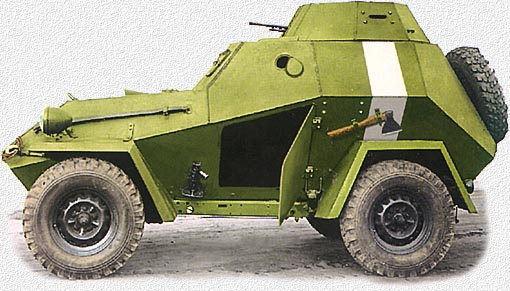
| Note: All Russian terms and abbreviations shown as red italic are described in the Glossary. |
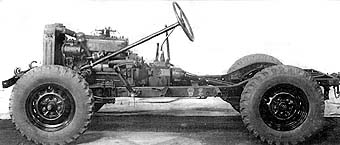 Chassis of the GAZ-64. |
Before the Great Patriotic War, the GAZ factory was the main supplier of driving gear for light armored cars like FAI, FAI-M, BA-20 and their variations. All those vehicles had two common disadvantages: their flotation ability was far from perfect and their armor protection was too weak. |
When the Great Patriotic War did start, the GAZ was in full swing of developing and manufacturing GAZ-64 light jeeps (Chief-engineer V.A.Grachev), designed upon military demands. Using their large experience, engineers of the GAZ's design bureau decided to develop a light armored car on the chassis of the GAZ-64. The new project received the "Izdelie 64-125" designation. On July 17, 1941 work on the new project started. The whole composition of further vehicles was designed by engineer F.A.Lependin, the Chief-engineer was G.M.Vasserman. The new vehicle highly distinguished itself from all off its predecessors. It was designed using the experience of modern war and latest demands of the Red Army. It supposed to be used as a reconnaissance and commander's vehicle, to fight against enemy paratroops, for motorcade's protection and for anti-aircraft protection of tank columns. The German Sd Kfz 221 had a certain influence on the design of the vehicle as well. By September 7, 1941, a Sd Kfz 221 was delivered to the GAZ factory. |
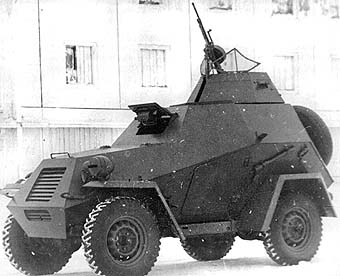 "Izdelie 64-125". January 1942. |
Despite lack of experience in developing armored hulls, Soviet engineers U.N.Sorochkin, B.T.Komarevsky, V.F.Samoilov and others could finish their work with big success. The armored plates of different thickness were fitted with rational angles which increased the overall protection of the armored car. Which gave the major superiority over the all previous Soviet armored cars and some of the German armored cars in the same class as well. This is especially true if we'll take the small weight into account. |
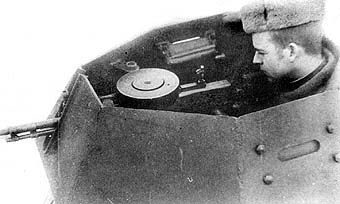 The DT machine-gun installation. Note the vision unit and antenna mount on the opposite side of the turret. |
However, having little weight and good armor protection, the new car had a very limited internal space. The crew consisted of two men: the driver's station was set up on the centerline of the car, the commander's station was behind the driver. Some other changes compared to the original GAZ-64 were made: the cooling system, ventilator and electric system were altered. The rear suspension bracket was strengthened also, but the most important improvement was made in the engine: now it could work on low-grade fuel and oil, which was of high importance for the army. |
Work on "Object 64-125" did run quickly. By the end of November 1941 the hull was completed, by January 9, 1942 the first prototype of the new armored car was finished. On February 17, 1942 it was named "BA-64", where the "BA" means "broneavtomobil" (armored car). Because it's turret wasn't completed yet, the 7.62 mm DT machine-gun was mounted on the open machine-gun ring. Next day (Jan 10, 1942) the vehicle was showed to K.E.Voroshilov. On March 9, 1942, after successful trials, designers were ordered to improve some shortcomings. On March 14, 1942, the BA-64 armored car was accepted for service. First, all armored hulls were manufactured by Vyksunskiy Factory, then manufacture was organized on GAZ. By May 1942, the first three armored cars were manufactured and sent to Governmental trials, which they passed successfully. In June 1942, the first party of new armored cars were sent to the Eastern front. |
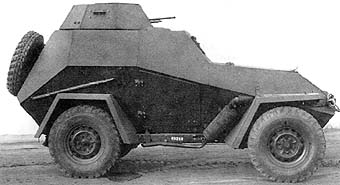 The early variant of the BA-64. |
The BA-64 was the first Soviet armored car with four-wheel drive, and it could climb 30° slopes, cross 0.9 m ford and 18° slippery hill-sides. The vehicle could move on sand very well. The survivability of the BA-64 was increased by using bullet-proof tyres. |
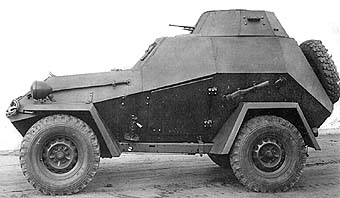 The later variant of the BA-64. |
The driver's observation visor was made of removable bullet-proof glass (also known as triplex). The same glass was used for the turret's embrasures. The 7.62 mm Degtyarev's machine-gun was mounted on a universal machine-gun ring, which allowed a 360° rotation. Some of BA-64's (41.5%) were equipped with wireless RB-64 or 12-RP. |
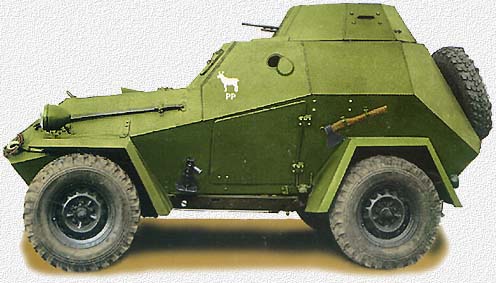
After the beginning of the BA-64's mass production, constructors started with the modernisation of this armored car. The main disadvantage was discovered - poor side steadiness (stability). Which was because of the narrow track (the space between wheels). So the track was increased to 1446 mm and two shock-absorbers were added to the front suspension. Beside this, some other minor improvements were made. At the end of October 1942 the "wide-track" BA-64 (or BA-64B) successfully passed all trials and was accepted for service. The improved wide-track chassis allowed to list on 25°. From the spring of 1943 up to 1946 mass production of the modernised BA-64B continued. In 1944, by a report of NKO, the monthly output of the BA-64B was 250 cars, yearly output of the radio-equipped BA-64Bs was 1404. Notwithstanding their weak armament, BA-64 armored cars were used successfully in most reconnaissance operations as well as for infantry support. Most successful was the BA-64 in street fighting, where the ability to fire on upper floors was very important. BA-64's and BA-64B's were used in all major operations and battles of the Eastern Front. A total of 8174 armored cars from both types were accepted for the Red Army, 3390 of which had a wireless. In 1946, the last 62 vehicles were manufactured, bringing a total of 3901 BA-64's and 5209 BA-64B's being manufactured. |
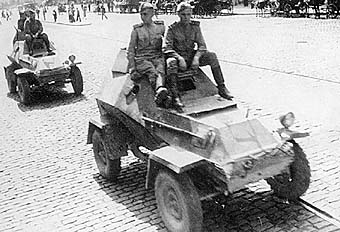 BA-64B's on the streets of the liberated Bucharest. 1944. |
After the war, BA-64B's served in the Soviet Army as training vehicles until 1953. Other countries of the Warsaw Pact used them much longer. Poland received 81 BA-64's and BA-64B's, Czechoslovakia - 10, DDR (Eastern Germany) used them as police armored cars. Many vehicles were sent to Yugoslavia, China and Northern Korea. |

| Parameter | BA-64 | BA-64B |
|---|---|---|
| Crew | 2 | 2 |
| Weight, kg | 2360 | 2425 |
| Length m | 3.66 | 3.66 |
| Width, m | 1.53 | 1.69 |
| Height, m | 1.9 | 1.85 |
| Armor, mm | 4-15 | 6-15 |
| Armament | 1 x 7.62 mm DT | 1 x 7.62 mm DT |
| Ammo | 1260 rounds | 1260 rounds |
| Engine | "GAZ-64" 4-cylinder, 50 hp | "GAZ-64" 4-cylinder, 54 hp |
| Fuel, liters | 90 | 90 |
| Range, km | 540 | 560 |
| Max speed, km/h | 80 | 80 |

| REFERENCES: Modifications of the BA-64 armored car Specifications of Soviet tank guns |
Sources:
"The BA-64 armored car. Short manual", Moscow, Voenizdat, 1943 "The armored cars", NIIBT Poligon GBTU KA, Kubinka, 1944 "Vezdekhody RKKA", Armada #7 "M-Hobby" #4 1999. |